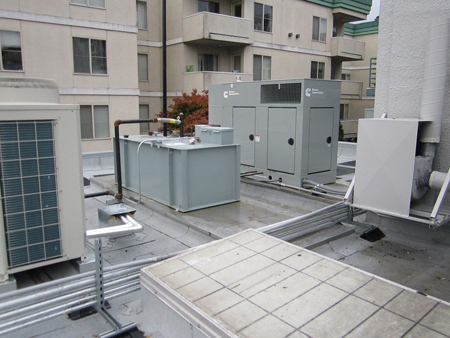
Fire Station No. 16
General contractor: Howard S. Wright
Architect: Hoshide Wanzer Williams
Electrical engineer: Travis Fitzmaurice & Associates
Owner: City of Seattle
Fire Station No. 16, dating from 1928, is one of five Mission Revival-style stations in Seattle and is considered a historic landmark.
Located in the Greenlake neighborhood, it is one of the older stations to be modernized under Seattle's Fire Facilities and Emergency Response Levy Program.
Due to the size of the land parcel, no expansion could be done. Thus, all modernization efforts were internal and aesthetic, the largest scope of which was electrical work.
SME Inc. of Seattle performed line voltage installations and managed three specialty electrical subcontractors, all while working in the cramped confines of the existing station.
The unavailability of working space and limited space above suspended ceilings created the largest coordination challenge for the project team. SME's work included all raceway systems for power, lighting, data, alerting, paging and access controls. Careful attention was paid to the location of horizontal penetrations through interior walls to minimize coring costs.
SME chose conduit pathways that avoided ductwork and sprinkler piping whenever feasible. In some instances, this led to conduit runs being longer than anticipated, however SME relocated very few above-ceiling items due to conflict throughout construction. Additionally, the owner's design team approved SME's request to allow conduits to be run on the roof to provide even more space inside for other building systems.
The project schedule was more aggressive than was stipulated in the bid proposal documents. In order to achieve the early completion date, the team often used fragmented installations, out of sequence work, and frequent task shifting.
To combat the potential delays, SME used prefabrication to build ahead of schedule, out of sequence and deliver to the site just in time for installation. Concrete beams spanned the entire width of the apparatus bay and the equipment located in the beam pockets required access by multiple trades, causing significant congestion and elevation conflicts.
SME mitigated most of the issues by prefabricating long linear runs of lighting to install in the bay. The fixtures were mounted on a strut, with the top of the strut used to secure conduit runs for other systems. The approach kept the electrical systems mostly out of the beam pocket areas, making installations by the other trades more efficient and aesthetically appealing.
The main electrical room required a new steel structure and pan decking prior to service gear-related work being done. SME installed its wall rough-in and received cover inspections to maintain the critical path schedule in 80 percent of the facility prior to beginning any incoming feeder and service gear activities.
SME encouraged owner and user walk-throughs so that changes could be done with minimal time and cost impacts. Although changes added 32 percent to labor costs, SME was able to identify these early enough to not significantly impact the schedule.
The project was completed on time and there were no recordable incidents in the 2,445 hours worked.